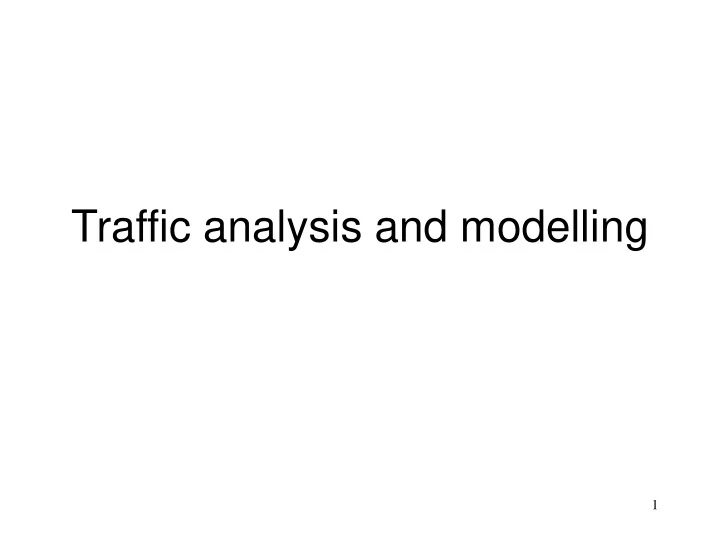

Traffic analysis and modelling 1
Service classification • Services may be classified according to many criteria. For example, loosely classify according to nature of transmitted information: – voice services – computer communications, and LAN-LAN interconnect – still picture transmission – full motion video – multimedia services • aim to identify qualitative traffic characteristics of these services which need to be taken into account in network performance evaluation, control, and design 2
Modeling Traffic: packet stream characteristics • essential to characterise the way data is generated within a connection – for network design, dimensioning and control • need to define parameters which can be used to determine: – allocation (dynamic) of resources required by a connection; – call admission control strategies; – flow control strategies; – congestion avoidance strategies; – charging; and – forecasting. 3
Modeling of Traffic: packet stream characteristics (cont.) • due to statistical multiplexing of variable bit rate sources modeling of aggregate behavior very difficult • The statistics desired from these models are moments of queue length, moments of delay distributions and probabilities of packet loss and buffer overflow (required at the extreme percentiles). 4
Examples of traffic source behaviour • constant bit rate (e.g. voice) – A periodic stream of packets whose period is the quotient of the effective line rate divided by the source rate, e.g. 53 bytes long note: effective line rate =(48/53)*line rate effective line rate/source rate Note: strict periodicity can be altered as packet stream proceeds across network due to random queueing delays introducing jitter. • important parameters: – mean packet rate=peak packet rate 5
Examples of traffic source behaviour (cont.) • on-off type – as for constant bit rate, but with on (active, burst) and off (inactive, silence) periods 53 bytes long eff. line rate/source rate note: eff. line rate =(48/53)*line rate • important parameters: –peak packet rate –distribution between on and off periods –mean packet rate (can be calculated from above) –correlation between successive on-off periods 6
Examples of traffic source behaviour (cont.) • variable bit rate 53 bytes long eff. line rate/instantaneous source note: effective line rate =(48/53)*line important parameters: –peak packet rate –mean rate –correlation between successive packets –others (e.g. higher order cumulants) ? • multimedia traffic ? –a combination of above? 7
Classifying parameters for traffic • mean packet rate • variance of instantaneous packet rate • correlation of instantaneous packet rate • others (e.g. higher order moments and cumulants)? • Which classifying parameters are important ? 8
Which classifying parameters are important ? An example • Consider a finite 100 packet places buffer, serviced at a rate of 1 packet per time. The system is sampled at a rate of =30 packet times. Let be the input process, and be the net output process (service rate). Note =30 packets/time period • Consider the following stream of packets/interval 100 packet places buffer Bn An 9
Which classifying parameters are important ? An example (cont.) • Case 1) 10,10,10,10,10... – the mean packet rate is 10 packets/time period – Clearly the server can cope with this mean rate, as it can serve 30 packets/time period, and the mean rate is 10 packets/time period . • Case 2) 1000,0,0,..,1000,0, 1000 zeros – the mean packet rate is 1000/1001 packets/time period – Clearly the server cannot cope with this rate even though the mean rate is << case 1. It is clear that during the periods that 1000 cells arrive heavy losses will occur as the server can only process 30 cells/time period . – Therefore it is clear that just the mean cell rate is not enough. We need to know the variance also 10
Which classifying parameters are important ? An example (cont.) • Case 3) 90,0,0,90,0,0,90,0,0,90,... – the mean rate is 30 and the variance is 1800. – Clearly the server can cope with this mean rate and variance. But is the mean and variance enough ? • Case 4) 90,90,90,0,0,0,0,0,0,90,90,90,0,0,.. – the mean rate is 30 and the variance is 1800. – Even though case 3) and 4) have the same mean and variance the server cannot cope. Heavy losses will still occur during the successive arrival of 90 packets/time period . 11
Which classifying parameters are important ? An example (cont.) Therefore it should be clear that mean and variance are not enough to characterise traffic. We also need information about the correlation (covariance) between successive time intervals, and possibly other parameters and models of behavior mean Loss probability variance model ? autocovariance Unfinished work distribution Other? Other? 12
Models for traffic characterisation • Not as simple to characterise integrated services traffic as with POTS, • Some commonly proposed models – voice connections: Poisson; holding time 3 minutes – data connections • connection oriented: on-off type; holding time ? (msecs to hours) • connectionless: ? – LAN data: MMPP; holding time: ? (msecs to hours), Self similar traffic models, … – video • entertainment: variable bit rate AR or MMPP; holding time hours • video telephony: constant bit rate, Poisson or MMPP; holding time 3 minutes • … – others ? 13
Some suggested modelling techniques (for various traffic types, views, and uses) – Poisson model – The G/D/1/K based cell scale models – An approximation renewal process – The Interrupted Poisson Processes (IPP) – The fluid flow approximation models – The 2 state Markov Modulated Poisson process (2-state MMPP) – The 2-state Markov modulated fluid model – The Batch Markovian Arrival Process (BMAP) – The Discrete Markovian Arrival Process (DMAP) – The Autoregressive Markov Model – The switched Bernoulli Process – The threshold Model – Models based on chaos theory – Models based on control theory 14
Self similar traffic models to capture aggregated data traffic behaviour 15
Self similar traffic models to capture aggregated data traffic behaviour (cont.) 16
17
18
19
20
21
Recommend
More recommend